

Street Directory of Commercial Road, south side, 1899
Underlining denotes people and/or trades at the same premises in 1921, to which most of the links giving more detail refer.
|
2 James Harrington, beer retailer 4 Jeremiah Sullivan, fruiterer [1] 6 George Francom, hosier 8 Matthew Nicholas, coffee rooms 10 Midland Railway Receiving House [2] 12-16 Capital & Labour Association ...here is Plough Street... 18 William Straker, stationer [3] 20 Solomon Levenberg, grocer 22 East London Dispensary [4] 24 G.M. Lion & Co., wholesale clothiers [5] 30 Samuel Law, coffee rooms 30A Abraham Moses, tailor 30A Reliance Deposit & Loan Co Ltd, I Kaliski, Secretary [6] 30B Woolf Harris & Son, Birmingham & Sheffield warehouse [7] 32 James Jabez & Seymour William Chalk, timber merchants (Riga Yard) 34 Seymour William Chalk 36 Harvey, Lerwill & Willis, hay salesmen 36 William Davey, corn merchant 38-40 London Salvage Corps, James Ford, superintendent 42 Thomas Watson, veterinary surgeon 44 Castle, John Frederick Wahlers ...here is Goodman's Stile... 46 London & India Docks Joint Committee Wool & Bonded Warehouse / London, Tilbury & Southend Railway Goods Station, D Edward Munns, superintendent 46-50 Gun Makers' Company's Proof House, John Spencer, barrel proof master / Gun Makers' Hall, Frederick T. Ashton, clerk ...here is Gower's walk... 52 Cohen, Weenen & Co tobacco manufacturers Improved Industrial Dwellings (Morrison buildings) George Plumby carpenter (Morrison buildings) ...here is Back Church Lane... 62 Boundary tavern, Frederick James Fryer 64 Story, Holliday & Co, scale makers [8] 66 Samuel Harris, fruiterer 68 William James Murray, carman 70 Israel Marienstraus, cheesemonger 72 Barnett Schwartz, tailor 74 Ernest Mœller & Co, wholesale stationery dealers 76-78 Joseph Michael Sullivan, wholesale tobacconist [9] 80 M Altmann, incandescent gas fittings manufacturer [10] 82 Morris Davies, provision dealer ...here is Berner Street... 84-6 William J Harris & Son, tobacco manufacturers [11] 88 Albert Wagener, beer retailer 90 Carl Wolgang, hairdresser 92 Francis George Cheesman, harness maker [12] 94 Samuel Schmidt, hairdresser 96 John Harman, oilman 98 W J Fraser & Co, engineers [13] ...here is Batty Street... 100 Edward Bell & Co, chemists [14] 100 Frederick William Blackwell, surgeon 102 [& 169] John Henry Tirrell, butcher 104 Benjamin Duck, beer retailer 106 Isaac Kahan, money changer 108 Aaron Levy, hat maker 110 Max Spigel, tobacconist 112 Aaron Posenheim, tinplate worker [15] 114 William Williams, corn dealer ...here is Christian Street... 116 Mrs Louisa Fisher, pawnbroker 118 Israel Israel, clothier 120 Henry Whiting, shirt & collar dresser 122 John Walker Bland, wholesale stationer 124 Charles Sitzler, hair cutter 126 Charles Campbell Birkett, dining rooms 128 King's Head, Herbert Thomas Stow ...here is Grove Street... 130 Israel Barnett, leather seller 132 Solomon Levy, tailor 134 [& 160] Harris Cohen & Sons, haberdashers [16] ...here is St George's Terrace... 136 Jacob Kutchinsky, baker [17] 138 Mrs Mary Ann Tucker, umbrella maker ...here is Umberston Street... 140 Samuel Russell Larcombe, beer retailer 142 Isaac Lewis, provision dealers |
144 William Brumpton, coffee rooms [18] 146 Mrs Betsy Iserliss, midwife 146 Israel Volin, confectioner 148 Lewis Bloomenfeld, watchmaker [19] 150 Isaac Woolf, hairdresser 152 Moses John Hickman, undertaker [20] ...here is Morgan Street... 154 Harris Bass, fruiterer 156 Isaac Abraham, tailor 156-8 Mackworth Arms, Otto Meyer 160 [& 134] Harris Cohen & Sons, haberdashers ...here is Cannon Street Road... 162 Louis Frumkin, wine & spirit dealer 164 Marcus Joseph, bookseller 164 Marks Rubenstein, purse maker 164 Edmond Beal Bacon, bootmaker 166 Hermann Schlesinger, mantle manufacturer 168 Simon Cohen, confectioner 170 Bernhard Morris, surgeon 172 Krayer Greenberg, draper 174 Nathan Amdur, butcher [21] ...here is Little Turner Street... 176 Edward Emptage, cycle agent [22] 178 John Arnold Woolman, butcher 180-2 John Furlong, clothier 184 Mrs Hettie Goldstein, milliner 186 Isaac Perkoff, photographer [23] 188 Gustave Michael MB CM, surgeon] 190 Thomas Brock, confectioner 192 Joseph Himpfen, baker [24] 194 Society for Organising Charitable Relief, Thomas Mackay, honorary secretary 194 Augustus George Crowder ...here is Richard Street... 196 Hyman Krimstein & Son, tobacconists 196 Jacob Dvorsky, butcher 198 Mrs Sarah Amis, fruiterer 200 Mrs Elizabeth Knight, draper 202 Samuel Marks, newsagent 204 Joseph Reiter, wholesale provision merchant 206-8 William Smellie, tripe dresser [25] ...here is Jane Street... 210 Jacob Bosman, fried fish shop 212 Samuel Davies, watchmaker 214 Isaac Caplan, fruiterer 216 Thomas Oates, grindery dealer 218 William Harries, cowkeeper 220 Max Brenner, hairdresser 222 Moses Goodman, confectioner 224 [& 365] Rafel Wolskey, butcher ...here is Anthony Street... 226 Tee-To-Tum Tea Stores [26] 226 Buchanan's Young Men's Institute, Joseph Nicholson, honorary secretary [27] 226 Buchanan's Social Club & Benefit Society, John Anderson, secretary [27] ...here is Upper Fenton Street... 228 James Isaacs, window glass cutter 228A Philip Boxer & Co, chandlers shop 230A Jacob Czershorski, butcher [28] 230 Lord Nelson, Mills Brothers ...here is Buross Street... 232 Isaac Michaels, tobacconist 234 Samuel Lisst, hairdresser 236 William Gates, coffee rooms 238 Grosman & Pinsky, furniture dealers 240 William Augustus Ayton, beer retailer ...here is Hungerford Street... Commercial Road Chapel [& see 322] 242 Benjamin Pizer, rag merchant 242 John Middleton, carman 242A Nathan Levy, tailor 246 Mrs Caroline Matten, beer retailer ...here is Planet Street... 248 Lewis Madenberg, tobacconist 248 Barnett Silverstone, shoemaker 250 Marks Fletcher, cap maker 252 John Wood & Co, corn dealers 254 Mrs Martha Ellen Carrington, coffee rooms ...here is Winterton Street... |
German Wesleyan Church 262 Barbican Mission to the Jews (Prediger) Christlieb Tragott Lipshytz, secretary [29] 264 Levene Margolinski, furniture dealer [30] 266 William Francis Trawley, beer retailer ....here is Watney Street... 270 William Wilson, travelling draper 272 Chandler Bros, carmen 282 George Merritt, relieving officer 284 Henry Harris, apartments 292 J B Dodsworth, rate collector [31] 294 Frederick James Dodsworth, house agent [31] 296 Jacob Goldstein, tailor 298 Louis Crocker, boot manufacturer ...here is Dean Street... 300 Sargent & Sargent, surgeons [32] 302 Frederick William Dix, wholesale stationer 304 Nathan Schor, jeweller 306 Bert Walker, artificial teeth maker 312 Harris Cohen 314 William Edward Grandy MB, surgeon [32] 316 Lewis Symonds, commission agent 318 James Hood & Sons, auctioneers &c 320 William Moss 322 Rev Joseph Fletcher 324 Abraham Alexander, tailor 328 Convent of the Little Company of Mary, nursing sisters, Rev Mother Ethelreda, superior 330 Abraham Benabo, appraiser [33] 332 Charles Mitchell, cigar manufacturer 334 Moss & Gray, house agents 334 Augustus William Tanner, district surveyor [34] ...here is Sutton Street East... 336-8 James Walker & Sons, bakers 340-2 Frost Bros Ltd, rope makers St Mary & St Michael's (Catholic) Church 342 Mrs Mary Amelia Mason, dressmaker 344 [& 369] William Riddle, cheesemonger 346 Frederick Franklin, portmanteau maker ...here is Lucas Street... 348 Wiiliam George Dickenson, beer retailer 350 George Jones, musical instrument maker 352 Frederick Hutchinson, coffee rooms 354 [& 27 & 543] Edmund Richard Goodrich, oilman 356 Joseph Hadida, watchmaker [35] 358 Josph Dodd, bicycle maker 360 Henry Roome, newsagent 362 [& 321] Morgan Evans, dairy 366 Nelson Heard Hocking, butcher ...here is Johnson Street... 368 London & South Western Bank Ltd, Ernest Noel Oxley [36] 370 Alex Grant MA MD, surgeon [32] 372 John Lynch, surgeon ...here is Harding Street... 378 William Henry Godier, fishmonger [37] 380 John Jeffery, beer retailer 382 Lewis Levy, confectioner 384-94 Church Training Coll for Lay Workers, Rev Ernest Robert Ford MA, warden 396 East End Mothers' Home, Miss Sarah E Bloomfield, lady superintendent 398 James Smith & Son, drapers 400 Rev George Thomas Cull-Bennett (St John's Vicarage) 402 George Morton, travelling draper 404 Arthur & Rogers, surgeons 406 [& 418] George Henry Derby, china dealer 408 Peter Dennison, cowkeeper 410 Robert Mitchell, corndealer 412 Charles Cooper Amis, waste paper dealer [38] 414 Edwin Light, beer retailer ...here is Devenport Street... 416 Eliazar Woolf, tailor 418 [& 406] George Henry Derby, oilman [39] 420 Samuel John Gray, printer ...here is Havering Street... 422 William Gillies, linendraper 424 Robert Capon Hayward, insurance superintendent [40] 426 Simon Garber, cigar manufacturer 432 Charles Hutchins 434 Maurice Wolff, shell merchant ...here is Albert Square... |
 [3] William Straker's stationery business was established in 1863, and by the turn of the century had several branches around London - right is their largest in 1910. The firm continues as W Straker Office Solutions, based in Brighton.
[3] William Straker's stationery business was established in 1863, and by the turn of the century had several branches around London - right is their largest in 1910. The firm continues as W Straker Office Solutions, based in Brighton. [6] The
Reliance Deposit & Loan Company, of which Isaac Kaliski, later
known as Isaac Kaye, was the Secretary, was voluntarily wound up in
1920 (by which time it was based at 16 New Road), with chairman
Abraham Moses and Kaliski as liquidators. Kaliski was a tailor by
trade, and was involved with several local synagogues, serving as
Secretary both of Old Castle Street and Princelet Street synagogues, and of the Chevra Tehillim u'mishmorim (Society for
Chanting the Psalms and Visiting the Sick) at the latter - the first of a number of
similar societies. He also became Secretary of Philpot Street Great
Synagogue, established in 1908 in the former Wycliffe Independent
Chapel
and refurbished in 1923. The previous year he appears to have arranged
for a flash photo to be posed and taken at the Yom Kippur service [right], which caused disapproval, and Kaliski, giving the synagogue as his address, was convicted in 1923 of what the magistrate
described as one of the worst cases of fraud he had seen - was this linked with the Reliance Company? Kaye
died in 1933 at Finchley Road, Golders Green (having previously lived
at Mapesbury Road, Brondesbury). The Isaac Kalisky Kaye charity for
the Jewish Poor, income to be distributed among the deserving poor
of Southend and Westcliffe, was closed in 2001.
[6] The
Reliance Deposit & Loan Company, of which Isaac Kaliski, later
known as Isaac Kaye, was the Secretary, was voluntarily wound up in
1920 (by which time it was based at 16 New Road), with chairman
Abraham Moses and Kaliski as liquidators. Kaliski was a tailor by
trade, and was involved with several local synagogues, serving as
Secretary both of Old Castle Street and Princelet Street synagogues, and of the Chevra Tehillim u'mishmorim (Society for
Chanting the Psalms and Visiting the Sick) at the latter - the first of a number of
similar societies. He also became Secretary of Philpot Street Great
Synagogue, established in 1908 in the former Wycliffe Independent
Chapel
and refurbished in 1923. The previous year he appears to have arranged
for a flash photo to be posed and taken at the Yom Kippur service [right], which caused disapproval, and Kaliski, giving the synagogue as his address, was convicted in 1923 of what the magistrate
described as one of the worst cases of fraud he had seen - was this linked with the Reliance Company? Kaye
died in 1933 at Finchley Road, Golders Green (having previously lived
at Mapesbury Road, Brondesbury). The Isaac Kalisky Kaye charity for
the Jewish Poor, income to be distributed among the deserving poor
of Southend and Westcliffe, was closed in 2001.
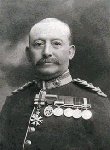 [7] Woolf Harris
[Halevi] was born in London in 1826 and married Phoebe in 1848; they
had five sons and two daughters. He was a hardware dealer, and died in
1905, by which time the firm was advertising as dealing in Birmingham
and Sheffield goods - that is, iron, brass and silver ware with
decorative finishes from the former, and cutlery and steel products
from the latter. His second son Sir David Harris (1852-1942 - left), the Grand Old Man of South African Jewry,
went out to the diamond fields in South Africa in 1871, and married in
Kimberly two years later; after moderate success as a prospector, he
became a diamond buyer and acquired claims of his own; he was an
associate of Cecil John Rhodes, and a director (later chairman) of De
Beers Consolidated Mines Ltd until his retirement in 1931. He was the
longest-serving member of the Cape Legislative Assembly, and an active
volunteer soldier, rising to the rank of Lieutenant-Colonel, taking
part in the suppression of the Bechuanaland rebellion of 1896-7 and the
Boer War in 1899-1902, and was awarded the KCMG in the 1911 Coronation
honours. See his 1931 memoirs Pioneer, Soldier and Politician. (A younger brother John also went out to South Africa and died there a few years later.)
[7] Woolf Harris
[Halevi] was born in London in 1826 and married Phoebe in 1848; they
had five sons and two daughters. He was a hardware dealer, and died in
1905, by which time the firm was advertising as dealing in Birmingham
and Sheffield goods - that is, iron, brass and silver ware with
decorative finishes from the former, and cutlery and steel products
from the latter. His second son Sir David Harris (1852-1942 - left), the Grand Old Man of South African Jewry,
went out to the diamond fields in South Africa in 1871, and married in
Kimberly two years later; after moderate success as a prospector, he
became a diamond buyer and acquired claims of his own; he was an
associate of Cecil John Rhodes, and a director (later chairman) of De
Beers Consolidated Mines Ltd until his retirement in 1931. He was the
longest-serving member of the Cape Legislative Assembly, and an active
volunteer soldier, rising to the rank of Lieutenant-Colonel, taking
part in the suppression of the Bechuanaland rebellion of 1896-7 and the
Boer War in 1899-1902, and was awarded the KCMG in the 1911 Coronation
honours. See his 1931 memoirs Pioneer, Soldier and Politician. (A younger brother John also went out to South Africa and died there a few years later.)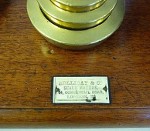
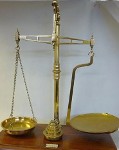 [8] Story, Holliday & Co, later Holliday & Co [right] were scale makers; see here for Herbert & Sons, another scalemaking firm on St George's Street.
[8] Story, Holliday & Co, later Holliday & Co [right] were scale makers; see here for Herbert & Sons, another scalemaking firm on St George's Street. 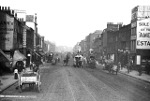
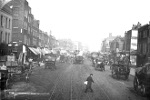 [11] William J Harris & Son's premises are pictured left in the 1880s; right is a view from a few yards along the street. See here for other tobacco dealers.
[11] William J Harris & Son's premises are pictured left in the 1880s; right is a view from a few yards along the street. See here for other tobacco dealers.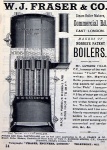

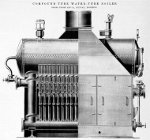
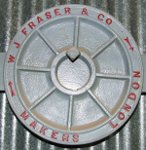
 [13] The Fraser company began in Houndsditch before 1830, moving in 1836 to Commercial Road. William John Fraser, of no.10, was granted patents in 1866 for improvements to steam boilers, also applicable to hot water and other boilers, and in 1868 for improvements to furnaces or fireplaces.
His partnership with George Coleman Fraser and John Hazel Fraser as
Fraser Bros, engineers, and tank and boiler makers, at 98 Commercial
Road and Railway Iron Works, Bromley-by-Bow, was dissolved in 1880; he
continued at Commercial Road and his brothers at the other site. Left
are trade illustrations for Morris's patent boilers (1888), Lyon's
Apparatus for Purifying Feed-Water (1894) and a compound water-tube
boiler (1895).
[13] The Fraser company began in Houndsditch before 1830, moving in 1836 to Commercial Road. William John Fraser, of no.10, was granted patents in 1866 for improvements to steam boilers, also applicable to hot water and other boilers, and in 1868 for improvements to furnaces or fireplaces.
His partnership with George Coleman Fraser and John Hazel Fraser as
Fraser Bros, engineers, and tank and boiler makers, at 98 Commercial
Road and Railway Iron Works, Bromley-by-Bow, was dissolved in 1880; he
continued at Commercial Road and his brothers at the other site. Left
are trade illustrations for Morris's patent boilers (1888), Lyon's
Apparatus for Purifying Feed-Water (1894) and a compound water-tube
boiler (1895). 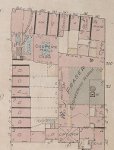 Right are
their premises on Goad's 1899 insurance map: the office on the corner
of Commercial Road and Batty Street, with the works behind. In the
Pharmaceutical Journal for 1900 they advertised
for sale One nearly new Copper
Vacuum Pan, 5 ft. diameter, fitted with Stirring Gear, Condenser and
all fittings. One Mild Steel Steam Jacketted Still, 4 ft. diameter,
fitted inside with Copper Steam Coils, Stirrer and Pulleys, Galvanised
Iron Still Head. A major product was a hydrogen
lamp for use in mines, which as well as providing illumination gave a
more accurate indication of methane levels in the air. Frasers made
mechanical improvements to the cylinder, made under a patent from
Redwood & Clowes, with a lamp patented by Ashworth - more details here and here.
A private company from 1904, it moved to Dagenham in 1910. In 1947 it
had a plant in Monk Bretton, near Barnsley; by the 1960s, with a staff
of 250, they were specialising in the design and construction of
petroleum, chemical and refinery plants (including BP's refinery at
Llandarcy), with their head office at Harold Hill near Romford.
Right are
their premises on Goad's 1899 insurance map: the office on the corner
of Commercial Road and Batty Street, with the works behind. In the
Pharmaceutical Journal for 1900 they advertised
for sale One nearly new Copper
Vacuum Pan, 5 ft. diameter, fitted with Stirring Gear, Condenser and
all fittings. One Mild Steel Steam Jacketted Still, 4 ft. diameter,
fitted inside with Copper Steam Coils, Stirrer and Pulleys, Galvanised
Iron Still Head. A major product was a hydrogen
lamp for use in mines, which as well as providing illumination gave a
more accurate indication of methane levels in the air. Frasers made
mechanical improvements to the cylinder, made under a patent from
Redwood & Clowes, with a lamp patented by Ashworth - more details here and here.
A private company from 1904, it moved to Dagenham in 1910. In 1947 it
had a plant in Monk Bretton, near Barnsley; by the 1960s, with a staff
of 250, they were specialising in the design and construction of
petroleum, chemical and refinery plants (including BP's refinery at
Llandarcy), with their head office at Harold Hill near Romford. 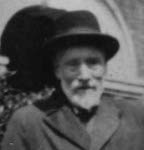 [21] Samuel Nathan Amdur
(1863-1943), right, married Sarah Zuker - both born on the Russian-German
borders - and they came to London, where they raised six children. They
lived at 25 Kinder Street until 1894, then at 174 Commercial Road; by
1901 they were living in Mile End Old Town. At some point his
Lithuanian-born parents Eliahu Dov and Menucha Amdur also came to
London; they died in Queen Street, Whitechapel in 1913 and 1914. Amdur
was a kosher butcher, and died in 1943 at Morgan Houses, Hessel Street.
[21] Samuel Nathan Amdur
(1863-1943), right, married Sarah Zuker - both born on the Russian-German
borders - and they came to London, where they raised six children. They
lived at 25 Kinder Street until 1894, then at 174 Commercial Road; by
1901 they were living in Mile End Old Town. At some point his
Lithuanian-born parents Eliahu Dov and Menucha Amdur also came to
London; they died in Queen Street, Whitechapel in 1913 and 1914. Amdur
was a kosher butcher, and died in 1943 at Morgan Houses, Hessel Street.
 [23] In 1887 Isaac Perkoff
(1870-1948) came to London with his father Michael from Kiev in the
Ukraine; they set up a photographic business, which Isaac then took
over from his father, opening a studio in Commercial Road and later one
near the family home The Vines on Lea Bridge Road, Clapton, employing
several staff. He won various prizes, including an Award of Merit in
London in 1895, a Silver Medal from the Polytechnic Technical School,
Regent Street, in 1896 for finishing enlargements, black and white,
and a Silver Medal at the 1896 Paris Exhibition. Isaac abandoned his
father's observant practices and became a left-wing Zionist,
much-involved with Yiddish arts, writing plays and poems and
translating the works of Sholem Aleichem (on whose stories Fiddler on the Roof is based).
He and his wife Anna raised eight children, and many of his pictures
are of his extended family, as well as of ordinary immigrant families
(who saved up for the all-important studio portrait) and of political
and artistic figures, including the First Central Committee of the
Workers' Circle (see here for local links), of Sholem Aleichem and the actor-manager
Maurice Moscovitch. Left is a self-portrait from his studio, and a
mid-1930s picture of Perkoff aged 65 with a friend Mr Fine at
Westcliff-on-Sea. See here for other photographers working in the area.
[23] In 1887 Isaac Perkoff
(1870-1948) came to London with his father Michael from Kiev in the
Ukraine; they set up a photographic business, which Isaac then took
over from his father, opening a studio in Commercial Road and later one
near the family home The Vines on Lea Bridge Road, Clapton, employing
several staff. He won various prizes, including an Award of Merit in
London in 1895, a Silver Medal from the Polytechnic Technical School,
Regent Street, in 1896 for finishing enlargements, black and white,
and a Silver Medal at the 1896 Paris Exhibition. Isaac abandoned his
father's observant practices and became a left-wing Zionist,
much-involved with Yiddish arts, writing plays and poems and
translating the works of Sholem Aleichem (on whose stories Fiddler on the Roof is based).
He and his wife Anna raised eight children, and many of his pictures
are of his extended family, as well as of ordinary immigrant families
(who saved up for the all-important studio portrait) and of political
and artistic figures, including the First Central Committee of the
Workers' Circle (see here for local links), of Sholem Aleichem and the actor-manager
Maurice Moscovitch. Left is a self-portrait from his studio, and a
mid-1930s picture of Perkoff aged 65 with a friend Mr Fine at
Westcliff-on-Sea. See here for other photographers working in the area.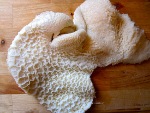 [25]
When Soumeliers (winegrowers from St Emilie, possibly Huguenots) came
from France to Scotland their name took its present form. In the 18th
century William Smellie was a pioneer obstetrician - the first to teach midwifery in a scientific manner - and another William Smellie
was the first editor of Encyclopaedia Britannica. The one who settled
in Shadwell (and had connections with St Paul's Church) was a baker,
but later a gentleman of some propertry, which on his death in 1823 he
left to his wife and children. His grandson William (1821-99) appeared
in most census and other documents as a tripe dresser, but in some as butcher,
and the family had butcher shops in Ben Johnson Road, Stepney and
Shadwell High Street, with a tripe factory round the corner in Dellow
Street [right on Goad's 1887 insurance map].
[25]
When Soumeliers (winegrowers from St Emilie, possibly Huguenots) came
from France to Scotland their name took its present form. In the 18th
century William Smellie was a pioneer obstetrician - the first to teach midwifery in a scientific manner - and another William Smellie
was the first editor of Encyclopaedia Britannica. The one who settled
in Shadwell (and had connections with St Paul's Church) was a baker,
but later a gentleman of some propertry, which on his death in 1823 he
left to his wife and children. His grandson William (1821-99) appeared
in most census and other documents as a tripe dresser, but in some as butcher,
and the family had butcher shops in Ben Johnson Road, Stepney and
Shadwell High Street, with a tripe factory round the corner in Dellow
Street [right on Goad's 1887 insurance map].  His address is given as Nassau Place (which became 206
Commercial Road) in an 1867 mortgage, when he was one of the trustees
of the First Middlesex Benefit Building Society, but he also had a
connection at no.23. However, he moved on - first to Wick Place, Bow
and then to Ivy Cottage, 90 Romford Road in Stratford: a large old
house in a big garden with a statue and fountain. By 1871 he had 32
employees; ten years later he had retired. When he died he left £1600,
and his three sons carried on the business - one of whom (the one
listed above) was also William. On the site of Ivy Cottage is now Topaz
House, part of which is Highway Church.
His address is given as Nassau Place (which became 206
Commercial Road) in an 1867 mortgage, when he was one of the trustees
of the First Middlesex Benefit Building Society, but he also had a
connection at no.23. However, he moved on - first to Wick Place, Bow
and then to Ivy Cottage, 90 Romford Road in Stratford: a large old
house in a big garden with a statue and fountain. By 1871 he had 32
employees; ten years later he had retired. When he died he left £1600,
and his three sons carried on the business - one of whom (the one
listed above) was also William. On the site of Ivy Cottage is now Topaz
House, part of which is Highway Church.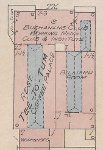 [27]
Harold Buchanan, who ran the University Club attached to Oxford House
in Bethnal Green, set up the Federation of Working Men's Social Cluibs,
which by 1894 had 60 branches and 6,000 members across London, of which
Buchanan's Young Men's Institute, Social Club and Benefit Society [left on
Goad's 1899 insurance map, together the premises above] was one.
Writing in 1889, Charles Booth listed all the known clubs in the area,
dividing them into 'politicial', 'social', 'philanthropic and
religious' and 'proprietary' - see his comments here.
[27]
Harold Buchanan, who ran the University Club attached to Oxford House
in Bethnal Green, set up the Federation of Working Men's Social Cluibs,
which by 1894 had 60 branches and 6,000 members across London, of which
Buchanan's Young Men's Institute, Social Club and Benefit Society [left on
Goad's 1899 insurance map, together the premises above] was one.
Writing in 1889, Charles Booth listed all the known clubs in the area,
dividing them into 'politicial', 'social', 'philanthropic and
religious' and 'proprietary' - see his comments here. [29] The Barbican Mission to the Jews
began work in that area in 1879, taking its title in 1891. It was
staffed by Jewish Christian converts, and held missionary meetings (at
which hymns were set to well-known Hebrew or Yiddish melodies), ran a
children's home, and offered medical assistance, which desperate Jewish
families took up despite their suspicion of its conversionist approach.
From 1889 the director was the Rev, or Prediger [preacher] Haim
Christlieb Traugott Lipshytz [left], a learned man who was a member of the Royal Astronomical Society. Here
is an account by a Jewish convert who worked at the mission's reading
room in Whitechapel. The society expanded into work in Eastern Europe,
particularly Poland, Czechoslovakia and Yugoslavia; see here
for the rescue work of the Revd and Mrs I.E. Davidson of a hundred
children from Prague during World War II. In 1976 the mission merged
with the International Society for Evangelisation of the Jews as
Christian Witness to Israel.
[29] The Barbican Mission to the Jews
began work in that area in 1879, taking its title in 1891. It was
staffed by Jewish Christian converts, and held missionary meetings (at
which hymns were set to well-known Hebrew or Yiddish melodies), ran a
children's home, and offered medical assistance, which desperate Jewish
families took up despite their suspicion of its conversionist approach.
From 1889 the director was the Rev, or Prediger [preacher] Haim
Christlieb Traugott Lipshytz [left], a learned man who was a member of the Royal Astronomical Society. Here
is an account by a Jewish convert who worked at the mission's reading
room in Whitechapel. The society expanded into work in Eastern Europe,
particularly Poland, Czechoslovakia and Yugoslavia; see here
for the rescue work of the Revd and Mrs I.E. Davidson of a hundred
children from Prague during World War II. In 1976 the mission merged
with the International Society for Evangelisation of the Jews as
Christian Witness to Israel.| A remarkable lawsuit over £11,000 left by James Godier, a Billingsgate fishmonger, was settled on Saturday by an arrangement between the parties concerned. Godier married Bella Taylor, his housekeeper, two days before her first husband's funeral and thereafter revoked a will in which he made various bequests to members of his family. The exors claimed that he was not in his right mind when the mariage was contracted. This was the third time Godier had been married, and Emily Godier, a daughter by his first wife, told the court that the children of one marriage lived on one floor and those of the second on another. Counsel stated that the matter had been considered by both sides, and on the terms arranged the will would be pronounced for so that its terms could be carried out. It was distinctly understood, added counsel, that the marriage was not to be considered invalid. Both sides agreed on that. |
 Right
is a trading token of Godier and Britton, fish sellers of 10 Lower
Thames Street in the City, where they traded from 1892-1910. (The other
one, on the right, is from Mills & Crome at no.7.) They were found
at the water's edge in 2012.
Right
is a trading token of Godier and Britton, fish sellers of 10 Lower
Thames Street in the City, where they traded from 1892-1910. (The other
one, on the right, is from Mills & Crome at no.7.) They were found
at the water's edge in 2012.Back to Commercial Road 1921 | Back to History